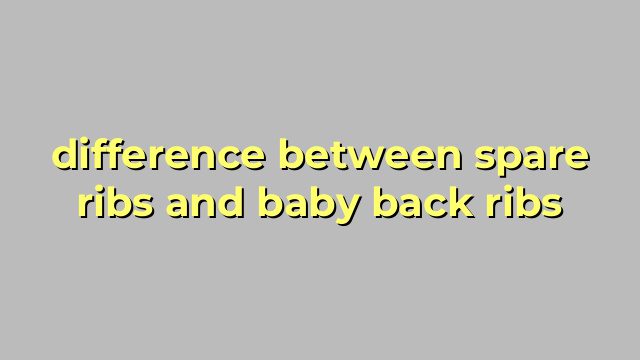The Differences Between Spare Ribs and Baby Back Ribs
If you are a fan of ribs, you might have come across two distinct terms – spare ribs and baby back ribs. While both are pork ribs, they differ in several crucial aspects such as size, texture, fat content, and flavor profile. In this article, we will explore the differences between spare ribs and baby back ribs.
Size
Spare ribs, also known as pork spare ribs, are larger and meatier than baby back ribs. They are cut from the bottom section of the pig’s rib cage, closer to the belly. Spare ribs have more connective tissue and large bones, making them ideal for low and slow cooking methods like smoking, baking, and grilling.
Baby back ribs, on the other hand, are smaller and leaner compared to spare ribs. They are cut from the top section of the pig’s rib cage, closer to the loin. Baby back ribs are shorter and curved, which makes them ideal for grilling and broiling.
Texture
Spare ribs have a chewy and tough texture due to their higher content of connective tissue and bone. They require extended cooking times to become tender, and the meat may require a bit of effort to pull off the bone.
On the other hand, baby back ribs have a more tender and softer texture. They have less connective tissue, making them easier to cook and eat.
Fat Content
Spare ribs have a higher amount of fat compared to baby back ribs. The fat, commonly known as the pork belly, runs along the rib bone and contributes to the meat’s flavor and moisture.
Baby back ribs, being leaner, have less fat content. Thus, they may require basting or marinating to maintain their moisture during cooking.
Flavor Profile
Sparing ribs and baby back ribs differ in flavor profile due to the fat content and bone structure. Spare ribs have a strong pork taste and a smoky flavor from extended cooking time, which makes them ideal for barbecue and smoking.
Baby back ribs have a milder flavor due to the lower fat content. They tend to absorb marinades and rubs better, making them more adaptable to various flavors.
In conclusion, understanding the differences between spare ribs and baby back ribs is crucial, especially when preparing and cooking your favorite barbecue dishes. Spare ribs are meatier, chewy, and rich in flavor, whereas baby back ribs are lean, tender, and versatile in flavor. With these differences in mind, you can easily choose which type of pork rib to use for your next BBQ dish.
Table difference between spare ribs and baby back ribs
| Ribs | Spare Ribs | Baby Back Ribs |
|---|---|---|
| Definition | Section of ribs located closer to the belly | Section of ribs located higher on the back |
| Size and shape | Longer, straighter and flatter | Shorter, curved and meatier |
| Meatiness | Less meat in between the bones and more bone marrow | More meat in between the bones |
| Tenderness | Less tender | More tender |
| Flavor profile | Stronger and bolder flavor | Lighter and sweeter flavor |
